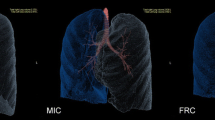Abstract
Background
Lung inflation and respiratory motion during chest CT affect diagnostic accuracy and reproducibility.
Objective
To describe a simple volume-monitored (VM) method for performing reproducible, motion-free full inspiratory and end expiratory chest CT examinations in children.
Materials and methods
Fifty-two children with cystic fibrosis (mean age 8.8 ± 2.2 years) underwent pulmonary function tests and inspiratory and expiratory VM-CT scans (1.25-mm slices, 80–120 kVp, 16–40 mAs) according to an IRB-approved protocol. The VM-CT technique utilizes instruction from a respiratory therapist, a portable spirometer and real-time documentation of lung volume on a computer. CT image quality was evaluated for achievement of targeted lung-volume levels and for respiratory motion.
Results
Children achieved 95% of vital capacity during full inspiratory imaging. For end expiratory scans, 92% were at or below the child’s end expiratory level. Two expiratory exams were judged to be at suboptimal volumes. Two inspiratory (4%) and three expiratory (6%) exams showed respiratory motion. Overall, 94% of scans were performed at optimal volumes without respiratory motion.
Conclusion
The VM-CT technique is a simple, feasible method in children as young as 4 years to achieve reproducible high-quality full inspiratory and end expiratory lung CT images.







Similar content being viewed by others
References
Long FR, Williams RS, Adler BH et al (2005) Comparison of quiet breathing and controlled ventilation in the high-resolution CT assessment of airway disease in infants with cystic fibrosis. Pediatr Radiol 35:1075–1080
Bankier AA, O'Donnell CR, Boiselle PM (2008) Quality initiatives. Respiratory instructions for CT examinations of the lungs: a hands-on guide. Radiographics 28:919–931
Long FR, Castile RG, Brody AS et al (1999) Lungs in infants and young children: improved thin-section CT with a noninvasive controlled-ventilation technique—initial experience. Radiology 212:588–593
Thomas KE, Wang B (2008) Age-specific effective doses for pediatric MSCT examinations at a large children’s hospital using DLP conversion coefficients: a simple estimation method. Pediatr Radiol 38:645–656
Zapletal A, Paul T, Samanek M (1977) Significance of contemporary methods of lung function testing for the detection of airway obstruction in children and adolescents (author’s transl). Z Erkr Atmungsorgane 149:343–371
Stanojevic SA, Wade A, Cole TJ et al (2009) Spirometry centile charts for young Caucasian children: the Asthma UK Collaborative Initiative. Am J Respir Crit Care Med 180:547–552
Castile R, Mead J, Jackson A et al (1982) Effects of posture on flow-volume curve configuration in normal humans. J Appl Physiol 52:1175–1183
Robinson TE, Leung AN, Moss RB et al (1999) Standardized high-resolution CT of the lung using a spirometer- triggered electron beam CT scanner. AJR 172:1636–1638
Raschle NM, Lee M, Buechler R et al (2009) Making MR imaging child’s play—pediatric neuroimaging protocol guidelines and procedure. J Vis Exp 30; pii: 1309. doi:10.3791/1309
Vilozni DO, Efrati O, Hakim F et al (2009) FRC measurements using body plethysmography in young children. Pediatr Pulmonol 44:885–891
Acknowledgment
The study was funded by the Cystic Fibrosis Foundation.
Author information
Authors and Affiliations
Corresponding author
Electronic supplementary material
Below is the link to the electronic supplementary material.
(MP4 4121 kb)
(M4V 28940 kb)
Rights and permissions
About this article
Cite this article
Mueller, K.S., Long, F.R., Flucke, R.L. et al. Volume-monitored chest CT: a simplified method for obtaining motion-free images near full inspiratory and end expiratory lung volumes. Pediatr Radiol 40, 1663–1669 (2010). https://doi.org/10.1007/s00247-010-1671-1
Received:
Revised:
Accepted:
Published:
Issue Date:
DOI: https://doi.org/10.1007/s00247-010-1671-1




